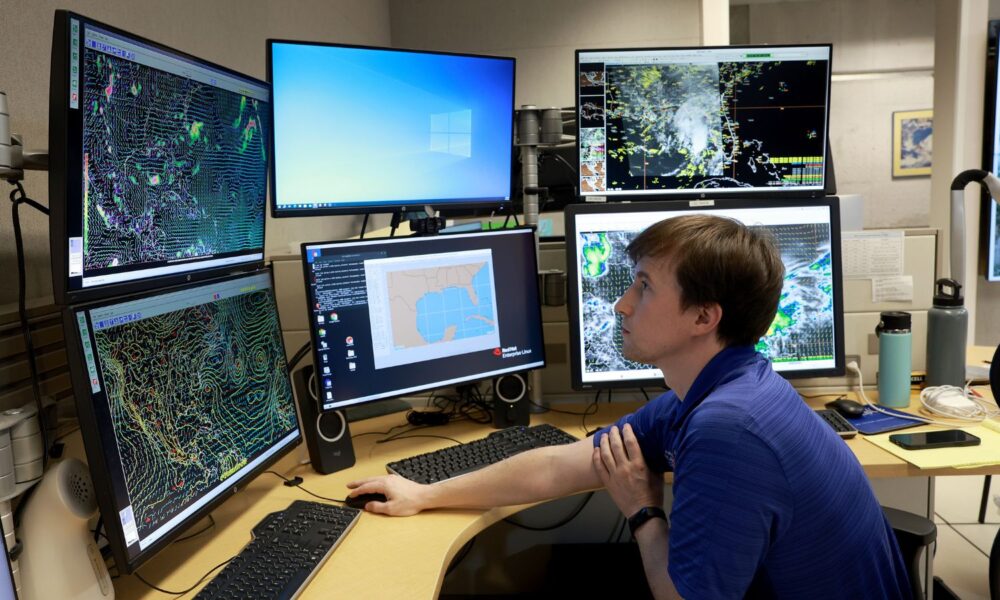By now it is clear the Trump administration is fulfilling the objective of Project 2025 to “dismantle” NOAA. It has cut critical research and grant programs, harassed and fired employees, and terminated external advisory boards that provide science-based review and recommendations for NOAA officials. It has attempted to close important observing systems, state marine advisory programs, and prestigious research labs. Over 1,000 employees recently departed, with many pressured to retire. Hundreds of others were fired without cause.
Now, Republican leaders in Congress are rushing to pass a budget bill that will terminate funding for observing, mapping, and community grant programs, shutter regional data portals, and eliminate hundreds of scientists. The proposed FY26 budget will be even more dire: it will decimate NOAA research, cut funding for weather satellites, and move parts of the National Marine Fisheries Service (NMFS) to the Department of the Interior. In short, this White House is taking a chainsaw to NOAA, cutting it up and selling it for parts.
NOAA’s roles and responsibilities are defined not by a single piece of legislation, but through roughly 200 statutes. Although it may appear to be a complex of offices, mandates, and missions, NOAA is truly much more than the sum of its parts. The “One NOAA” concept takes a fully collaborative and integrated approach across its six Line Offices, providing science, service, and stewardship to protect life and property while enhancing the US economy. Former NOAA Administrator Vice Admiral Conrad Lautenbacher described its operation as “one band, one sound,” like an orchestra where each instrument plays its part, contributing to a full symphony.
How did NOAA come together?
To understand the importance of NOAA in its present structure, a little history is in order. Some of its components and legislated duties originated in the early 19th century. Collectively, these were the building blocks of modern American science and technology, but were disconnected in different government departments.
President Richard Nixon released a Message to Congress in 1970 establishing NOAA, “pulling together into one agency” the scientific, technological, and administrative resources “scattered through various Federal departments and agencies.” His reorganization plan recognized the need for a single agency for “better protection of life and property from natural hazards.” It called for “exploration and development leading to the intelligent use of our marine resources.” It noted the importance of understanding the ocean and atmosphere as part of the “total earth environment” and charged NOAA specifically to “exercise leadership in developing a national oceanic and atmospheric program of research and development”, as well as the collection and dissemination of oceanographic data. NOAA would develop “extension and advisory services,” and provide support to other government agencies and industry and private individuals for “efficient operation” of our economic systems and our national security. Fun fact: this same Message to Congress created the Environmental Protection Agency (EPA).
Here are some examples of how integrated One NOAA services address our nation’s critical challenges and needs.
Weather forecasting
One contentious Project 2025 proposal is to decimate, relocate, and possibly privatize the National Weather Service (NWS). Understanding and predicting local weather involves much more than a few forecasters and media meteorologists. Accurate short-term alerts and daily and long-term forecasts rely on observations and research to understand and predict the atmosphere and how it interacts with the ocean—on scales from minutes to centuries, and from meters to thousands of miles.
Your weather service office bases its forecasts, advisories, and warnings on local knowledge and experience combined with NWS regional and national observations and models (which in turn rely on input from local observations). It also relies on satellite data from NOAA’s National Environmental Satellite, Data, and Information Service (NESDIS), marine buoy and ocean observations from its National Ocean Service (NOS), and aircraft reconnaissance from its Office of Marine and Aviation Operations (OMAO). NOAA’s National Centers for Environmental Prediction provide specialized guidance, and the NOAA Climate Prediction Center informs weekly to seasonal forecasts. These products and services are built upon and continuously improved by active research and monitoring from NOAA’s Oceanic and Atmospheric Research (OAR) labs and scientists.
Like with its other missions, NOAA facilitates essential partnerships with other federal agencies, states and tribes, academia, and the private sector to produce and sustain its myriad vital public services. Relocating these offices into disparate federal departments or privatizing their services would make this integration more difficult—and more costly for the taxpayer and the consumer.
Economic development
Consider the economy, the single greatest concern on many people’s minds. By many measures the largest bureau within the Department of Commerce, NOAA’s work informs and benefits the nation’s economy and virtually every traditional and emerging commercial sector. While these services may originate in different NOAA offices, the ability to integrate the data and science that support them is vital for their timely and informative distribution and use by the public, businesses, and communities.
NWS and NESDIS provide data and information about weather and climate for agriculture, energy, transportation, telecommunications, and construction; insurance and reinsurance; emergency management and public safety; and managing water resources and quality and drought.
They also maintain a record of weather events causing significant economic losses in the U.S., approaching $3 trillion since 1980 (at least until the administration announced it will no longer do so). NOAA also conducts and sponsors research that tracks economic and socioeconomic information on the New Blue Economy that includes the value of marine resources and the communities that depend on them: commercial and recreational fishing; marine navigation and transportation; the seafood trade; tourism and recreation; and coastal communities, economies, jobs, and services.
It also uses technology and data from across the agency to support economic growth, protect the ocean’s health, and find solutions to societal challenges. NOAA scientists evaluate and inform the nation on the value of non-monetary natural capital and ecosystem services as well as the benefits of monetary and physical capital to our economic wealth and performance.
NMFS economists monitor and analyze the value of fisheries and the import and export of seafood products and support our growing sustainable domestic aquaculture industry. NOS coordinates with NMFS and other federal bureaus to track employment, business, and the Gross Domestic Product dependent on the ocean and Great Lakes. NOAA also compiles proprietary foreign trade data from the Census Bureau and Customs Service for public use. Working with other agencies, developers, and coastal communities, scientists from NMFS, NWS, and NOS research and assess the impacts of offshore energy projects on fishing, shipping, and other marine activities, as well as protected species and their habitats. NOAA scientists assess damage from oil spills, hazardous material releases, and vessel grounding to ensure the public is fully compensated.
Public health
Our environment affects our individual and collective health. Air and water quality, human-animal interactions, weather extremes and climate change impacts, harmful algal blooms and marine toxins, and seafood safety. Each require observation and monitoring, research and modeling, and good policy.
NOAA combines its own data with that from other federal and state agencies to map heat waves on land and in the ocean, disease outbreaks related to weather, bacteria in shellfish beds, marine mammal strandings, and hazardous wildfire emissions. With its partners, including the regional Integrated Ocean Observing Systems (IOOS), EPA, and state public health and resource agencies, NOAA forecasts and monitors red tides and algal blooms, and their impacts to fish and humans. They remove and prevent hazardous marine debris.
The NOAA One Health initiative applies a collaborative and cross-sector approach using expertise across NOAA in ocean conservation, exploration, and stewardship, fisheries management, climate science and research, weather forecasting, and satellite monitoring, to address potential or existing health risks to humans, animals, and plants.
America’s environmental intelligence agency
Knowing the status and trajectory of ecosystem health and sustainability is essential to prudent stewardship, and the health and well-being of people, communities, and businesses. NOAA is America’s environmental intelligence agency. From OMAO’s research fleet, NESDIS satellites, NOS coastal monitoring sites, NMFS fishery surveys, and NWS buoys and radar, NOAA is the nation’s eyes on our planet. Place-based programs like the National Marine Sanctuaries combine NOAA research, education, and stewardship to protect iconic ecological, cultural, and recreational sites and support local economies. And NOAA OneStop enables open discovery and access to over 100,000 data sets, rather than needing to visit numerous government data portals maintained by multiple departments, or needing a private subscription service.
Each part of NOAA plays a role in monitoring, understanding, and predicting how the environment in which we live, work, and play is doing, and how it affects each of us. NOAA’s ability to successfully provide effective integrated services has been advanced by harnessing Big Data and developing and applying artificial intelligence tools. With these modern tools and its workforce of world-class scientists and technicians, NOAA accesses and integrates its broad array of observing systems and data and provides information to the public for timely decisions that can save lives and property, grow businesses and communities, and protect ecosystems.
A common theme throughout NOAA’s programs and services is their dependence on an integrated multi-office One NOAA effort. None of them operate alone. They are inextricably connected in their missions, their data, their research, and their services. Separating them into different departments or private companies will make their job more difficult if not impossible and degrade their services and assistance to the public.
What you can do
- Recognize the importance of NOAA in your own community, and how its different offices work together to serve you locally
- Let your friends and neighbors, your social media networks, and your local print and broadcast media know how One NOAA serves everyone in your community, every day.
- Remind your representatives of their responsibilities in oversight of NOAA and its legislated mandates and appropriations.
- Tell your representatives to stand up for science and preserve much needed investments in NOAA offices and programs during the ongoing FY25 budget reconciliation process. Ask them to fund critical NOAA programs in the FY26 budget.
- Press for the return of federal science advisory committees—particularly the NOAA’s Marine Fisheries Advisory Committee (MAFAC), Climate Services Advisory Committee, and Marine and Coastal Area-based Management Advisory Committee—to provide expert review and recommendations for agency officials. Ask for the formation of independent advisory committees by scientific societies and those outside of government.
- Share this One NOAA summary with your own network
Since its establishment in 1970, presidents on both sides of the aisle have considered reorganizing NOAA, but came to understand the role and interconnection of each part and responsibility. With each new administration, the incoming Secretary of Commerce seems to be surprised to learn that NOAA is part of their department. Most quickly realize it is their crown jewel, through its value to commerce and communities, and the impressive return on the government’s investment in its programs, research, and services.
Some organizational changes to NOAA have been made since its inception. But these have been based on thoughtful objective analysis, assessing costs and benefits, reviewed and informed by expert federal advisory committees, and in consultation with those impacted: states and tribes, partners and stakeholders, businesses and communities. Not by moving fast and breaking things, and not by taking a chainsaw to one of our foremost science agencies.

